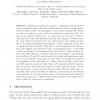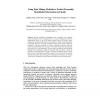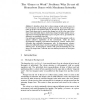815 search results - page 55 / 163 » Predictive Modeling with Heterogeneous Sources |
ILP
2007
Springer
14 years 4 months ago
2007
Springer
Machine-generated documents containing semi-structured text are rapidly forming the bulk of data being stored in an organisation. Given a feature-based representation of such data,...
ADMA
2008
Springer
14 years 4 months ago
2008
Springer
Private information management and compliance are important issues nowadays for most of organizations. As a major communication tool for organizations, email is one of the many pot...
BMCBI
2006
13 years 10 months ago
2006
The protein-protein interaction networks of even well-studied model organisms are sketchy at best, highlighting the continued need for computational methods to help direct experim...
CIKM
2011
Springer
12 years 10 months ago
2011
Springer
The study of information flow analyzes the principles and mechanisms of social information distribution. It is becoming an extremely important research topic in social network re...
CEEMAS
2005
Springer
14 years 3 months ago
2005
Springer
A honeybee colony has to choose among several nectar sources in the environment, each fluctuating in quality over time. Successful forager bees return to the hive and perform dance...



